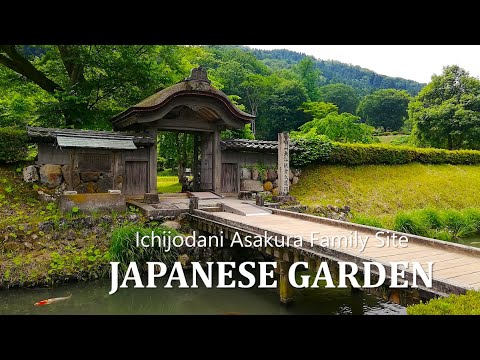Ichijodani Asakura Clan Ruins;
Kido-no-uchi-cho, Fukui City, Fukui Prefecture, JAPAN
#japenesegarden
#gardentour
#gardens
The Asakura Clan Ruins in Ichijodani is the remains
of a castle town from the Warring States period, located in Ichijodani, Fukui City, Fukui Prefecture. Approximately 278 hectares of the site have been excavated and preserved. From around 1500, this was the headquarters of the Asakura clan,
who ruled Echizen Province for five generations over a period of approximately 103 years
during the Warring States period. In this video, we will take a look at
the ruins of a garden located here, but it is a garden that has been left to return to nature. If you want to see typical and artificial Japanese gardens,
please enjoy other videos on this channel. The ruins of the Yudono-ato garden came into view. Asakura Family was a powerful clan from the Hyogo area, and in the latter half of the 1400s,
they pacified the surrounding area. They then constructed a planned urban space
with a neat town layout modeled after Kyoto, with samurai residences, temples, townhouses,
and craftsmen’s houses lined up in rows. When the Asakura clan was destroyed
by Oda Nobunaga in 1573, the townscape of Ichijodani was burned down and buried, and remained buried underground for about 400 years. This Yudono-at garden was
adjacent to Asakura Yoshikage’s residence and was designed as a strolling garden with a pond at its center, surrounded by artificial hills,
rock arrangements, bridges, and paths. Several gardens have been discovered
at the ruins of the Asakura clan in Ichijodani, the oldest of these is the Yudono-ato Ruins Garden,
which was built in the early 1500s. Whether you feel that several hundred years of history
is a long time or a short time is up to you, but in Japan, where most buildings are made of wood, it is not uncommon for towns to be destroyed by fire or war. In any case, this place is now a ruins,
so it may feel very old, but there are many examples of architecture and gardens from that period that remain in Japan today. This garden also reflects the Taoist philosophy
that was common at the time, and its design and stone arrangements seem
many similarities with existing gardens. The appeal of Ichijodani lies not so much in its rich history as in the pleasant atmosphere of the entire area,
including the surrounding landscape. We are heading to the Suwayakata-ato Garden. This area receives heavy snowfall in winter, which provides abundant water
and makes it ideal for rice cultivation. The Suwayakata-ato Ruins Garden is the largest garden in the Ichijōdani ruins, created for
Asakura Yoshikage’s concubine. It features large rocks, a two-tiered pond, and abundant curves, and is highly regarded for its expression
of feelings toward his concubine and its cutting-edge design
from the late Warring States period. This garden is designed so that
you can see the back of the garden. This is the view from behind the rock where the water was falling. You can see where the water flowing through the garden comes from as it falls into the pond. Excavations at the Asakura Site began in 1967, and in addition to samurai residences,
temples, and townhouse ruins, a variety of artifacts have been unearthed, including pottery and tools that provide insight into daily life. On the other hand, I think the reason why
it does not have the dull atmosphere often found in Japanese archaeological sites It is well maintained, but nature
and human activity remain intact, allowing you to see scenes like those depicted in old Japanese tales. We proceed further into the ruins to see the last garden. As some of you may have already noticed,
doesn’t this area feel a little strange? That’s right. There are bears in this area. The day before my visit,
there were reports of bears in the area. I always walk with bear bells ringing. In this area, I was walking toward the last garden
while fighting the urge to turn back. In Japan, bears are found not only here
but also in many areas outside of urban areas, so bells are an essential item when traveling. Recently, there have been cases
of people being attacked and killed by bears, or falling unconscious, so when walking in such areas in Japan,
it is necessary to take serious precautions. Nanyoji was a nunnery built for the children of the Asakura clan. Although there are no traces of the temple itself, the ruins of the garden that was built there remain today. It is said that there was a beautiful cherry tree in the garden. This is where a banquet was held to
view the cherry blossoms with Yoshiaki Ashikaga, who later became shogun. The garden design also reflects the idea of immortality. It is believed to have been built at the same time
as the two gardens we have already seen. Go about 3 km toward the back of the town. Ichijo Falls, with a majestic waterfall cascading 12 meters. This is a place where you can see
the rich water resources of the area. Ichijo Valley gives the impression of being a place for people who are interested in history
and nature rather than gardens. If you like this video, please subscribe
and give it a thumbs up👍. Thank you for watching!


Comments are closed.